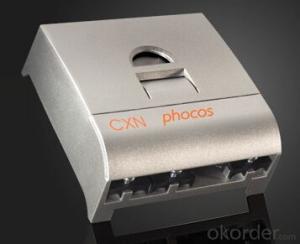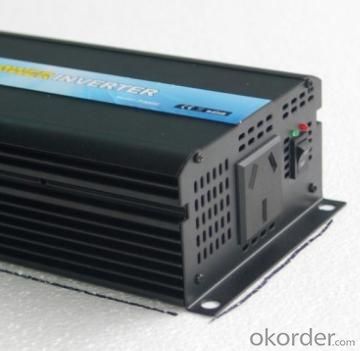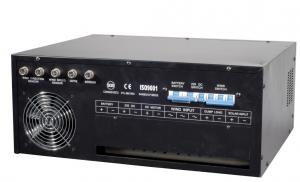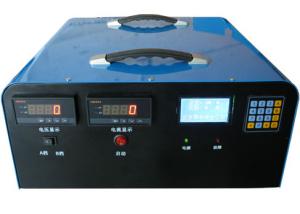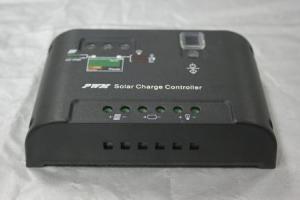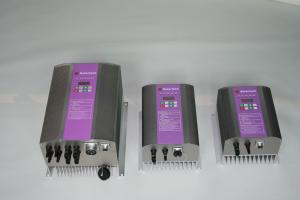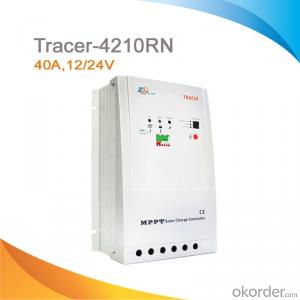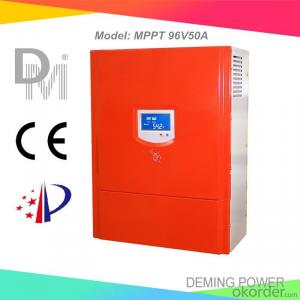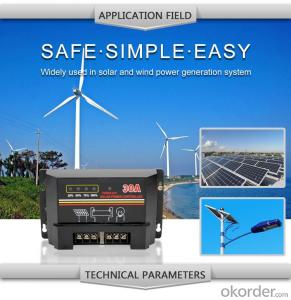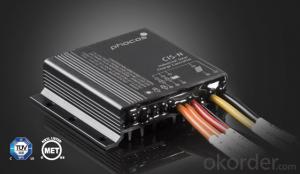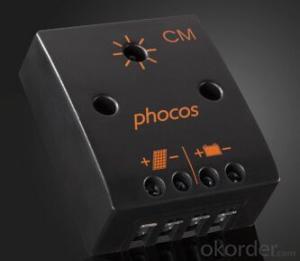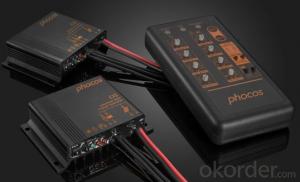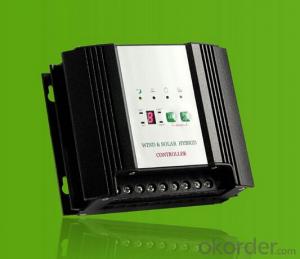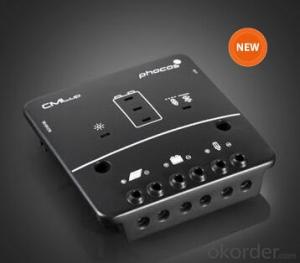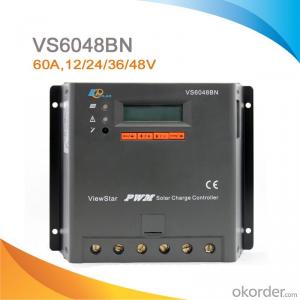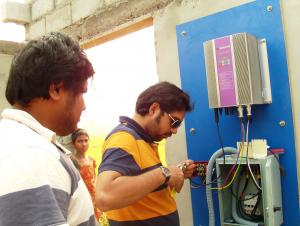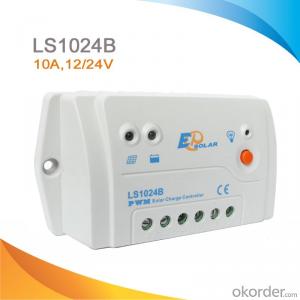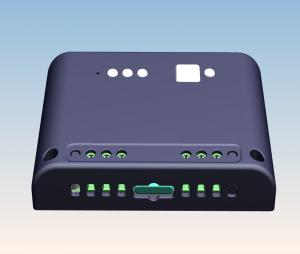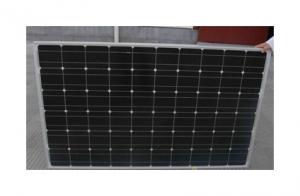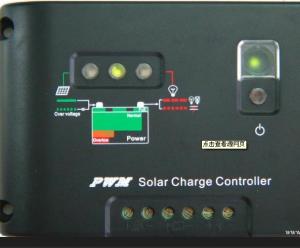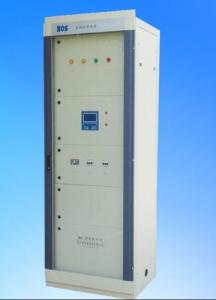Multiple Solar Charge Controllers - Solar CXN Series (10 – 40 A) Programmable Solar Charge Controller with Negative Grounding
- Loading Port:
- China Main Port
- Payment Terms:
- TT or LC
- Min Order Qty:
- -
- Supply Capability:
- 10000 unit/month
OKorder Service Pledge
OKorder Financial Service
You Might Also Like
1, Product desciption
The DC power for the inverter section can be derived from a normal AC wall outlet or some other source. Control and feedback circuitry is used to adjust the final output of the inverter section which will ultimately determine the speed of the motor operating under its mechanical load.
Motor speed control needs are numerous and include things like: industrial motor driven equipment, electric vehicles, rail transport systems, and power tools. (See related: variable-frequency drive ) Switching states are developed for positive, negative and zero voltages as per the patterns given in the switching Table.
The generated gate pulses are given to each switch in accordance with the developed pattern and thus the output is obtained.
2, Features of the product
Inverters convert low frequency main AC power to higher frequency for use in induction heating.
To do this, AC power is first rectified to provide DC power. The inverter then changes the DC power to high frequency AC power. Due to the reduction in the number of DC Sources employed, the structure becomes more reliable and the output voltage has higher resolution due to an increase in the number of steps so that the reference sinusoidal voltage can be better achieved.
This configuration has recently become very popular in AC power supply and adjustable speed drive applications. This new inverter can avoid extra clamping diodes or voltage balancing capacitors. There are three kinds of level shifted modulation techniques, namely
Is the electrical grid already nearby or would you need to call in the power company to bring in electrical lines.
If the electric needs to be brought to the area, how much is this going to cost? Depending on how far the grid electric is from the location of the needed lighting, this can be quite expensive.
How much lighting is needed on the street? Do the lights need to be dark sky compliant.
Do the street lights need to run from dusk to dawn or for only a specified number of hours at night.
Are the street lights able to dim in the middle of the night and still provide enough lighting.
These questions need to be answered before you can decide on how many lights you will need to complete the project.
3, Product Image
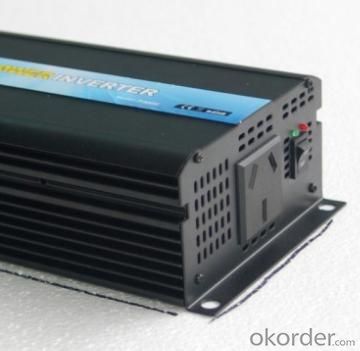
4, Detailed Specification
INPUT | |
Input voltage range | 185~265±5Vac |
OUTPUT | |
Output voltage range | 185~265±5Vac (AC mode) , 230Vac (DC mode) |
Output frequency (DC mode) | 50Hz (48~54Hz) or 60Hz(58~64Hz), same as AC(AC mode) 50Hz ±0.3Hz (DC mode) |
Wave form | Sine wave (DC Mode) |
Transfer time | 10ms. (Typical) |
BATTERY | |
Rated charging current (max.) | 45A |
Norminal DC input voltage | 12V |
Min. DC start voltage | 20V / 40V |
PHYSICAL | |
Unit dimension (mm) | 526*277*212 |
Master box dimension (mm) | 620*350*370 |
Net weight (1pc, kg) | 22.8 |
- Q: Can a solar controller be used with a solar hybrid system?
- Yes, a solar controller can be used with a solar hybrid system. The solar controller regulates the flow of energy between the solar panels, battery storage, and the grid, ensuring optimal performance and efficient energy management in a hybrid system.
- Q: Can a solar controller be used with solar panels that are partially covered?
- Yes, a solar controller can be used with partially covered solar panels. However, it is important to note that the efficiency of the solar panels will be reduced if they are partially covered, resulting in a lower overall power output. The solar controller will still regulate and control the charging process, but the amount of energy generated will be affected by the extent of the panel coverage.
- Q: How does a solar controller handle different charging stages?
- A solar controller manages different charging stages by regulating the flow of electricity from the solar panels to the battery. It monitors the battery's voltage levels and adjusts the charging process accordingly. During the bulk stage, it allows maximum current to charge the battery rapidly. In the absorption stage, it reduces the charging current while maintaining a constant voltage to ensure the battery is fully charged. Finally, during the float stage, the controller maintains a lower voltage to prevent overcharging and keep the battery in a fully charged state.
- Q: How does a solar controller handle battery low voltage disconnect recovery?
- A solar controller handles battery low voltage disconnect recovery by monitoring the voltage of the battery connected to the solar system. When the battery voltage drops below a predetermined threshold, typically around 11.5 to 12 volts, the solar controller will disconnect the battery from the load to prevent further discharge. Once the battery is disconnected, the solar controller will continue to monitor the battery voltage. It will wait for the battery voltage to rise above a specific level, known as the recovery voltage, before re-establishing the connection between the battery and the load. During the recovery phase, the solar controller will gradually increase the voltage supplied to the battery to avoid sudden spikes in power. This allows for a controlled and safe reconnection process, preventing any potential damage to the battery or the connected devices due to a sudden surge of power. The solar controller's ability to handle battery low voltage disconnect recovery ensures that the battery is protected from over-discharge, which can lead to irreversible damage and decreased battery performance. By disconnecting and then reconnecting the battery at appropriate voltage levels, the solar controller helps to prolong the life and efficiency of the battery, ensuring optimal performance of the solar system.
- Q: Can a solar controller be used with solar panels that are connected to a solar air conditioning system?
- Solar panels connected to a solar air conditioning system can indeed utilize a solar controller. Acting as a regulating device, the solar controller effectively manages the flow of electricity from the solar panels to the air conditioning system. Its primary function is to optimize the energy generated by the panels, ensuring efficient operation of the system. Monitoring the electricity output, controlling battery charging (if applicable), and directing the ideal power amount to the air conditioning system are all responsibilities of the solar controller. By employing a solar controller, seamless integration of the solar panels into the air conditioning system is achieved, resulting in maximum energy utilization and decreased reliance on the grid.
- Q: What is the maximum discharge voltage of a solar controller?
- The maximum discharge voltage of a solar controller varies depending on the specific model and manufacturer. However, in general, the maximum discharge voltage of a solar controller is typically around 12 to 24 volts. It is important to note that the discharge voltage should not exceed the maximum voltage rating of the connected battery system, as this can cause damage to the battery and other connected components. It is always recommended to refer to the product specifications and guidelines provided by the manufacturer for accurate information regarding the maximum discharge voltage of a specific solar controller.
- Q: How does a solar controller handle low battery voltage disconnect?
- The monitoring of the battery voltage level is how a solar controller handles the low battery voltage disconnect. When the battery voltage falls below a predetermined threshold, typically around 11.5 volts, the solar controller automatically disconnects the load from the battery to prevent further discharge. Maintaining the health and lifespan of the battery is crucial, making this feature indispensable. Once the battery voltage reaches a safe level, typically around 12.6 volts, the solar controller reconnects the load and resumes charging the battery. This prevents excessive discharge of the battery, which can cause irreversible damage and reduce battery capacity over time. Aside from low battery voltage disconnect, some solar controllers offer additional features to safeguard the battery. These include overcharge protection, which prevents the battery from being overcharged by the solar panels, and over-discharge protection, which prevents the battery from being discharged beyond a specified point. In summary, the low battery voltage disconnect feature of a solar controller is vital for maintaining battery health and longevity. It ensures optimal performance and maximizes the efficiency of the solar system.
- Q: Can a solar controller be used with a solar-powered vertical farm?
- Yes, a solar controller can be used with a solar-powered vertical farm. A solar controller helps regulate the flow of electricity from the solar panels to the farm's electrical system, ensuring optimal performance and preventing damage to the equipment. It plays a crucial role in managing the energy generated by the solar panels and maintaining the efficiency and sustainability of the vertical farm's operations.
- Q: Can a solar controller be used in a solar-powered electric skateboard charging system?
- Yes, a solar controller can be used in a solar-powered electric skateboard charging system. The solar controller helps regulate the flow of electricity from the solar panels to the skateboard's battery, ensuring efficient and safe charging. It helps prevent overcharging or undercharging of the battery, optimizing the charging process and extending the battery's lifespan.
- Q: How does a solar controller handle voltage drops in long wires between the solar panel and battery?
- The use of Maximum Power Point Tracking (MPPT) is a technique employed by a solar controller to address voltage drops in long wires between the solar panel and battery. This electronic system constantly monitors the solar panel's voltage and current output, adjusting the input voltage to the battery to ensure the maximum transfer of power. When voltage drops occur in long wires, the solar controller detects this decrease and compensates by increasing the input voltage from the solar panel. This compensates for any losses and ensures that the battery still receives the maximum power from the solar panel, even if there is a drop in voltage due to resistance in the wires. Furthermore, solar controllers often come equipped with built-in mechanisms for voltage regulation and protection. These mechanisms stabilize the voltage and safeguard the battery from overcharging or undercharging. They are capable of detecting when the voltage falls below a certain threshold and taking appropriate action to prevent any harm to the battery. In conclusion, a solar controller is designed to effectively handle voltage drops in long wires through the utilization of MPPT technology and the implementation of voltage regulation and protection mechanisms. This guarantees that the solar panel's power output is maximized and that the battery receives the necessary voltage for efficient charging, regardless of any losses that may occur in the wires.
Send your message to us
Multiple Solar Charge Controllers - Solar CXN Series (10 – 40 A) Programmable Solar Charge Controller with Negative Grounding
- Loading Port:
- China Main Port
- Payment Terms:
- TT or LC
- Min Order Qty:
- -
- Supply Capability:
- 10000 unit/month
OKorder Service Pledge
OKorder Financial Service
Similar products
Hot products
Hot Searches
Related keywords
